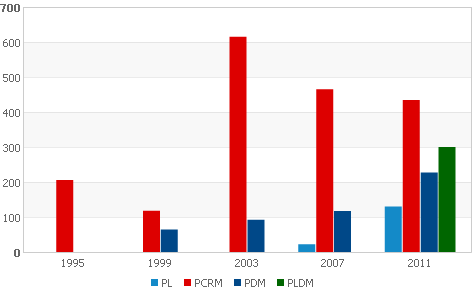ADEPT | Gagauzia 2016 | Presidential 2016 | Elections 2015 | Bashkan 2015 | Gagauzia 2012 | Political Parties
Preliminary results of 2011 local elections
Overall assessments
The high turnout of local elections on June 5 and 19, 2011 (53.7 percent while approximately 20 percent of citizens who have the right to vote are outside of the country and cannot participate in elections) was on a level with their importance. The political-administrative nature of local elections carries a series of nuances. Hence, the election of mayors has a preponderantly administrative nature, as concrete and well-known persons are elected in uninominal constituencies. The election of local councillors has a double political-administrative nature, as the voting is based on closed party lists, takes place in small constituencies with several mandates, and voters know the candidates relatively well. Finally, the election of district and municipal councils has a preponderantly political nature, as the voting takes place in very large constituencies which cover tens of localities, and candidates from closed party lists are almost strangers for voters. In consequence, the complex nature of local elections has a major impact both on local administration and political life in the country.
Administrative vote and anchorage of party branches in local public administration
Since 1990 until now the Republic of Moldova implemented three local administration and administrative-territorial organisation reforms, which annulled each other for populist reasons. In consequence, the local public administration is so far dependent on central authorities, being deprived of financial autonomy and development resources. Ruling parties fully profit by this situation. They are permanently interested to anchor their local branches in local administration — mayoralties and local councils — with the purpose to control local authorities and use them as administrative levers during parliamentary and local elections. On the other hand, local parties anchored in local administration are often interested to use the so-called administrative rent provided by control on local administrative organs. This state of things explains the poor interest of central and local authorities in the local public administration reform.
Table 1. Number of mayors (out of a total of 898) elected on behalf of incumbent parliamentary parties in five electoral cycles

This table reveals the results of the administrative vote in five electoral campaigns for mayoral elections. Parliamentary parties strengthened their positions in local public administration at the recent local elections, particularly the three parties representing the Alliance for European Integration (AIE). Instead, non-parliamentary parties got an unusual bad result, despite the discontentment of people with the state of things in their country. The Liberal Democratic Party of Moldova (PLDM) became an incontestable winner at administrative level, though it ran for local elections for the first time, but achieved an unprecedented performance, winning approximately one third of seats in all mayoralties. The Democratic Party of Moldova (PDM) and the Liberal Party (PL) doubled and respectively tripled the score they have got four years ago. In its turn, the Party of Communists of the Republic of Moldova (PCRM) lost approximately one third of mayoralties, compared with the results got in 2007. However, the PCRM got a better result at the recent elections in terms of election of mayors of cities and districts, getting approximately one third of seats, and this fact had a compensatory effect for the administrative and political potential of PCRM. The very good result of PCRM in urban centres is important because cities and administrative centres still have some economic units and may have an influence in perspective. On the other hand, it is worth noting that the result got by PCRM in cities and districts is mainly due to the ethnic vote of Russian-speaking citizens, as this party promoted a policy aimed to increase the ethno-linguistic phobias.
The results of elections in local councils reveal a kind of average of administrative authority and political rating of parties. In this respect, the PCRM rating is seriously falling, but this party defeated AIE members so far. As well as in the case of elected mayors, the PDM and PL doubled and respectively tripled their performances, and PLDM hit the roof as party which ran for local elections for the first time. Of course, the success of PLDM is due to the office of prime minister held by party leader Vlad Filat, while the nature of relationship between central and local authorities was explained above.
Table 2. Number of local councillors (out of approximately 11,000 in all 898 localities) elected on behalf of incumbent parliamentary parties in five electoral cycles

Results of elections in capital, Chisinau municipality
Although the PCRM was a dominant party in approximately half of 20 years of independence of the Republic of Moldova, controlling all central power, it had never won the electoral race in the capital of the country. Despite the modest general result on country, the PCRM would have been an incontestable winner of the recent local elections, if it conquered the Chisinau City Hall. Anyway, after two years of opposition, the PCRM was about to conquer the Chisinau City Hall, so that to get the best result ever recorded at municipal elections in Chisinau. The PCRM achieved just half of victory, winning near thing the race for the Chisinau Municipal Council. Although it won just 46.1 percent of the votes, by 2.8 percent less than the aggregated score of AIE members (PL — 31.8 percent, PLDM — 14 percent, PDM — 3.1 percent), the PCRM got the absolute majority of seats — 26 out of 51 — due to the d’Hondt seat distribution method.
The seat distribution method for parliamentary elections was curiously modified in June 2010 (the egalitarian seat redistribution method called Robin Hood replaced the d’Hondt method), but the d’Hondt method was preserved for elections in local councils. Thus, AIE members have no choice but to regret the failure to build an electoral bloc, so that to enjoy the d’Hondt method. In general, this example proves that incoherence and tensions inside of AIE are to blame for main problems faced by Moldovan society the last two years.
The victory of the candidate of the Liberal Party and AIE, Dorin Chirtoaca, in the race for Chisinau mayor was near thing, as he won only 1.2 percent more votes than his PCRM rival Igor Dodon. If law courts confirm the results of elections, Chisinau will sigh under the burden of a dual power the next four years. Given the fact that the true decision-making authority is in hands of the local council and the mayor is the executive authority of the council, under the effective law on local public administration, the Moldovan democracy lock model at central level could cover the management of Moldovan capital, too. A confirmation of sad expectations is the refusal of PCRM leaders to recognise the re-election of Dorin Chirtoaca as mayor, shortly after the runoff vote, and their decision to contest the results and demand repeat elections. Therefore, the next four years Chisinau residents will have a Municipal Council made of a majority due to the redistribution method, rather than to the majority vote, and a mayor whose mandate is unrecognised by the majority of the council.
Political vote and its impact on settlement of institutional crisis
The results of elections for district councils were expected to answer the question related to the opportunity to challenge early parliamentary elections in order to settle the institutional crisis — election of chief of state. The proportion of forces has generally changed to advantage the AIE. Indeed, the PCRM got 39.3 percent of the valid votes at the early parliamentary elections on November 28, 2010, while the AIE member parties won 52.1 percent. The PCRM won 36.9 percent of the valid votes at level of districts and municipalities at the recent local elections, while the AIE member parties got 54.2 percent. The difference increased by 4.5 percent in favour of AIE.
At a first glance, it seems that the PCRM should not keep insisting on an accelerated election of chief of state with the purpose to block again and challenge early parliamentary elections (see Table 3). But the state of things is not so simple. Despite the slow fall of political support for the PCRM, its rating is pretty high so far, and the PCRM keeps being the strongest political party. The major problem of PCRM rests with the incapacity to make allies, proving until now an extraordinary capacity to incite tensions, to make enemies and to constantly antagonise relations between massive segments of citizens by exacerbating ethno-linguistic phobias.
Table 3. Evolution of results of parliamentary elections and political vote of local elections for current parliamentary parties

Table 3 reveals the evolution of rating of parliamentary parties and is useful to understand the conduct of PCRM. After succeeding to the rule with a constitutional majority in 2001, the PCRM introduced in 2002–2003 under the pressing Transnistrian factor the initiative on European integration of the Republic of Moldova, which further deteriorated the relations with the Russian Federation dramatically. The political partnership aimed to implement European integration objectives and settle the Transnistrian conflict, established between the PCRM and the opposition turned into a massive boycott by a large segment of electorate against PCRM at the 2007 local elections. In consequence, the PCRM decided to cease the so-called political partnership for European integration and to resume old policies on confrontation with the opposition, which pressed by PCRM held post-electoral protests in April 2009 that turned into the so-called Twitter Revolution. Since 2009 the PCRM is trying to have revenge, but its rating keeps falling down slowly. PCRM is seeking ways to get back the rule after the recent local elections, too.
Two factors fuel the optimism of PCRM to rule the country again. The first is related to dissensions inside of AIE. The institutional crisis is not settled because some AIE members are afraid of the excessive strengthening of partners, rather than because of impossibility to elect the chief of state. If early parliamentary elections take place again because of incapacity to elect the chief of state, building AIE-3 would be absurd. Why to build AIE-3 if AIE-1 could not and AIE-2 did not want to elect the chief of state? Thus, despite the lower rating than before, but higher than of AIE member parties, the PCRM would become a natural major coalition centre made with at least one member of AIE, which would probably compete for the honour to build a coalition with the PCRM.
Secondly, the PCRM cannot stay in opposition any longer, since it realised that it left an eight-percent economic decline after losing the rule, and the economic fall was recovered in 2010, with the country achieving an 8-percent economic growth in the first three months. The PCRM would logically like to rule the country again, as the politics is the most profitable business in countries like Moldova, a fact proved even by conflicting AIE members at present. Indeed, PCRM wants to repeat the situation from 2001, when the Moldovan economy was destroyed after the August financial collapse in Russia, while the Alliance for Democracy and Reforms (ADR) revived it at the cost of own rating and the PCRM simply fructified the ADR sacrifice at parliamentary elections. PCRM has a nice strategy and its leader Vladimir Voronin did not accidentally tender resignation as chief of state in September 2009, though he could rule the country until now. However, by temporarily ceding the rule in order to let the AIE “pull chestnuts out of the fire”, the PCRM preserved the lever of challenging early parliamentary elections.
One should admit that the PCRM plan is achievable in principle. Majorities in district and municipal councils will be established soon and they will help clarify many things related to plans of key political parties. PCRM holds the absolute majority in 1/4f district and municipal councils and AIE member parties could control the other 3/4. All rests with the agreement of member parties.
Table 4. Number of district/municipal councillors (out of a total of 1,120 in all 32 districts and two municipalities) elected on behalf of incumbent parliamentary parties in five electoral cycles

Establishment of alliances at level of districts would credit the AIE with chances to succeed. An eventual failure of declared intentions to establish local alliances accompanied as usually by a dispute among AIE leaders would mean that the probability of early parliamentary elections followed by the comeback of the PCRM rule in coalition with an AIE member should not be neglected.
However, an eventual internal eruption inside of PCRM after the excellent result of the team of the PCRM candidate in the Chisinau municipality, Igor Dodon, compared with the lower result of the party in country in general, should not be ruled out. Nor the perspectives of this scenario are negligible, but confirmations are necessary before any talks.
|
2016 2015 2014 2012 2011 [14] 2010 2009 2008 2007 2006 2005 2004 2003 2002 2001
|
Elections [107] Foreign policy / European integration Political parties Transnistria Governmental policies Government — opposition relations Civil society / NGO Justice and legal bodies
|


